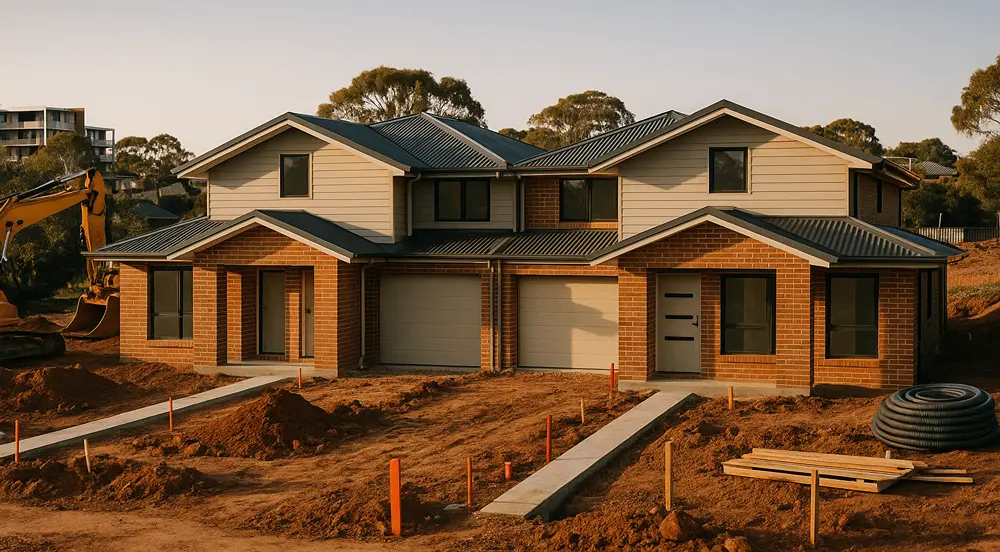The process of Estimating for Dual Occupancies involves site evaluation, design assessment, and precise cost breakdowns. Its importance lies in managing shared structures and separate utilities efficiently. Unlike standard projects, it requires balancing dual compliance, resource optimisation, and value engineering to maximise profitability in residential developments.
What makes dual occupancy estimating different from single dwellings?
Dual occupancy projects require a tailored approach due to their complexity. Unlike single dwellings, estimating for dual occupancies involves shared infrastructure, stricter regulations, and dual utility connections. These factors increase planning demands, requiring precise cost breakdowns to avoid budget overruns and delays.
Zoning laws and council requirements often differ for multi-dwelling projects. Estimators must account for additional compliance costs, such as fire safety and accessibility standards. Shared walls or separate structures also impact material and labour estimates, making accuracy critical for success.
Breaking down key cost elements in dual occupancy projects
Understanding cost components is vital for budgeting dual occupancy projects. Estimating for dual occupancies includes site preparation, construction materials, labour, and compliance fees. Each element must be calculated to reflect the unique demands of multi-dwelling developments.
Key costs include shared utilities like water and electricity, which require separate metering. Structural elements, such as reinforced foundations for attached dwellings, also drive expenses. Using residential estimation services ensures all variables, from permits to landscaping, are accurately factored into the budget.
Site preparation and subdivision costs in dual occupancies
Site preparation plays a critical role in dual occupancy budgets. Estimating for dual occupancies must include costs for clearing, levelling, drainage, and subdivision. These expenses vary depending on soil conditions, access challenges, or demolition of existing structures, often creating budget fluctuations that developers need to anticipate and manage effectively.
Subdivision costs involve surveyor fees, council applications, and utility connections. For example, subdividing a 600 sqm block may cost $20,000-$40,000 in Australia, depending on location. Proper planning ensures these expenses align with the overall project budget and timeline.
Estimating construction costs for shared and separate structures
Construction costs vary significantly with dual occupancy design. Estimating for dual occupancies requires assessing whether dwellings share walls or stand independently. Shared structures can reduce material expenses but require accurate calculations for load-bearing walls, fire separation, and insulation to ensure compliance, safety, and cost efficiency throughout the project delivery.
Separate structures increase expenses due to additional foundations and roofing. For instance, a 200 sqm duplex may cost $400,000-$500,000 to build. Accurate joinery estimating services help calculate costs for custom fittings, ensuring budgets reflect design-specific requirements.
Labour and subcontractors estimation services for dual occupancies
Labour costs remain one of the biggest challenges in dual occupancy projects. Estimating for dual occupancies requires coordinating subcontractors like electricians, plumbers, and carpenters. Precise scheduling for each trade is essential to avoid costly delays, minimise overruns, and ensure projects are completed efficiently while maintaining compliance and quality standards.
Subcontractor quotes must reflect the project’s complexity. For example, shared utility installations may require specialised trades, increasing labour costs by 10-15%. Detailed planning ensures all labour expenses are accounted for, keeping the project within budget and on schedule.
Hidden costs in dual occupancy estimating you should plan for
Unexpected expenses can derail dual occupancy projects. Estimating for dual occupancies must include contingencies for hidden costs like soil remediation, weather delays, or extended council approvals. These unforeseen issues typically add five to ten percent to the total project budget, impacting profitability if not managed carefully.
Common hidden costs include:
-
Unexpected utility upgrades
-
Compliance with new building codes
-
Delays due to weather or approvals Allocating a contingency fund of at least 10% ensures financial flexibility, preventing disruptions during construction.
Cost-saving strategies in dual occupancy construction projects
Smart planning helps cut expenses in dual occupancy projects. Estimating for dual occupancies should focus on cost-saving measures such as modular designs, efficient layouts, or shared utilities. These strategies reduce material and labour costs while ensuring compliance, maintaining quality, and maximising value for developers and investors.
For example, choosing energy-efficient materials can reduce long-term utility expenses. Bulk purchasing for both dwellings saves on material costs. Accurate cost estimation ensures savings are maximised while maintaining structural integrity and meeting council regulations.
Realistic timeframe and scheduling estimates for dual occupancies
Timely completion keeps dual occupancy projects profitable. Estimating for dual occupancies requires realistic scheduling, factoring in site preparation, construction, and approvals. A typical 12-18 month timeline includes 3-6 months for permits and 9-12 months for construction.
|
Phase |
Duration |
Key Tasks |
|---|---|---|
|
Planning |
3-6 months |
Permits, design, approvals |
|
Site Prep |
1-2 months |
Clearing, subdivision |
|
Construction |
9-12 months |
Building, inspections |
Accurate scheduling prevents costly delays, ensuring projects meet deadlines and budget expectations.
Can smart estimating turn dual occupancies into profit engines?
Effective cost management turns dual occupancies into profitable investments. By estimating for dual occupancies, developers optimise budgets, reduce risks, and improve returns. Careful planning, covering site preparation, labour, and service connections, ensures multi-dwelling projects meet quality standards while delivering strong financial outcomes across Australia.


